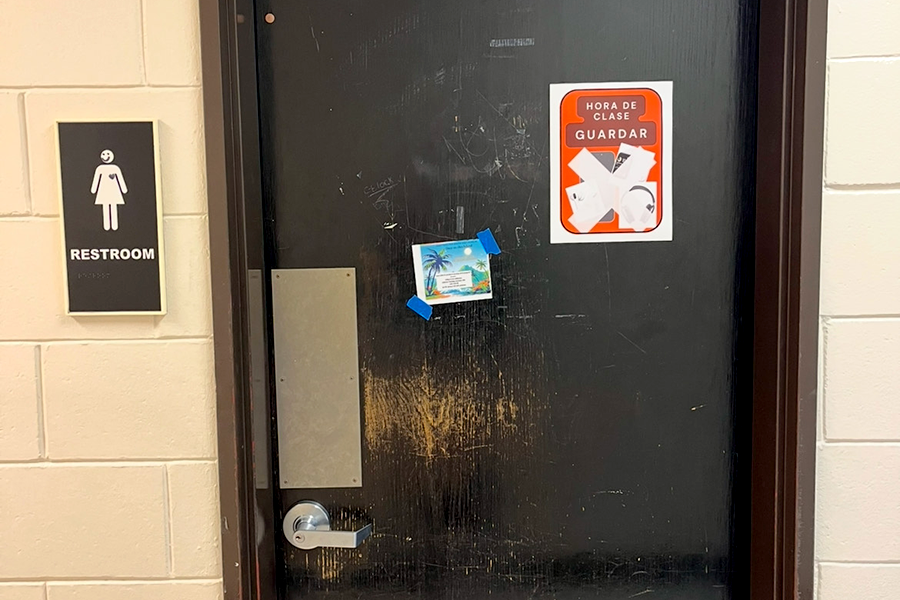Teaching is possibly the most mysterious of any profession. Due to the nature of the job, teachers’ personal lives are often hidden. The sense of this unobtainable knowledge intrigues many students and makes it that much more exciting when a teacher decides to divulge some of their carefully camouflaged experiences. But teachers walk a dangerous line between what is appropriate and entrancing to their students, and what is out of bounds inside a classroom. The school policy on teacher boundaries is very cut-and-dry. The administration supports the belief that education should be focused on student academic progress as opposed to the teacher’s lives or relationships with his or her students. Teachers are not encouraged to be outside of school with their current students unless it is a school-sponsored or class-related event. While there is no official policy on Facebook friending, Principal Cecilia Saddler stresses that it’s important to use it only for academic purposes and block any possible access to personal information.
“[Teachers] have to realize that it’s not about [them],” Saddler says, “It’s about the students.”
The difficulty in determining what is appropriate in the classroom is that the topic’s subjectivity. Several teachers at South have a similar approach to that of the administration. In a teacher survey, Laura Wagner, an All Nations Social Studies teacher, cited close teacher-student relationships as a source of disciplinary issues in the classroom.
“It’s a double edged sword,” she said. “It can show empathy, but can also open the door to inappropriate relationships.”
Many teachers voiced opinions similar to Wagner’s, adding that it is never appropriate to add a current student on Facebook. Throughout the responses of a school-wide teacher survey, there was a huge emphasis placed on the word “professional.” Many teachers repeated in their answers that it is important to remember that school is still a place of work, and any personal or “adult” problems should be left outside of the classroom.
Junior Clio Cullison disagrees, saying that it is “easier to learn from [teachers who share some aspects of their lives] because [students] respect them more.” While she agrees that this sharing can hurt a teacher’s authority in some situations, if the information is appropriate and presented professionally, it will just improve teacher-student relationships.
Many teachers place a great emphasis on making the classroom a welcoming and comfortable environment. Melinda Bennett, a science teacher at South, noted that “students are more perceptive to learning if they feel a personal connection.” In a survey of South students 60% of surveyed students agreed or strongly agreed that they learn better in classrooms in which their teachers discusses aspects of their lives with them. Senior Josh Arvold-Zismer feels that school and the strictness that it imposes can cause a great deal of anxiety for students. “That anxiety,” he claims, “can be avoided by staff truly connecting with their students.” He thinks that this can be done by teachers striving to be open and friendly in the classroom. Arvold-Zismer feels that when students aren’t as anxious, they are able to be more comfortable at school, and this helps them to be better students. According to the Children’s Center for OCD and Anxiety, having a safe person at school can make a huge difference for a student. They even say that it “can make the difference between a student attending school and staying home.” A teacher is a good person to take on this role, because they have everyday interactions with students. But in order to be a “safe person” for a student, a teacher must try to to foster a trusting relationship with their students.
Saddler agrees that classrooms need to be comfortable places for teens to learn and grow as both students and people.
“School,” she says, “is the place you learn almost everything.” Saddler says that this goal can be obtained with teachers sharing certain, appropriate aspects of their lives. Day-to-day activities or “PG” experiences are certainly fair game, but problems can arise when teachers start to talk about personal issues like relationships or drugs and alcohol. These topics can be unsettling for some students or their parents, particularly when the discussions are unrelated to the curriculum.
“I am more concerned about teaching values and respect than content,” Wagner says. She thinks that students today are too often taught how to act from the media, because parents have to work more than they used to. She adds that her role as a teacher is to help students grow as people.
According to Saddler, “enough” students have come in to talk to her about an uncomfortable classroom environment that was fostered by inappropriate teacher comments. Senior Jake Oman, who was recently made very uncomfortable by comments made by a teacher in class, agrees that teachers are best to keep their personal thoughts and experiences private.
“I don’t like when teachers talk about themselves,” said Oman, adding that he thinks that teachers being too honest with their students is likely to damage their authority in a classroom.
“Sometimes if you’re friends with your kids, they start to push back [on the teacher’s authority],” warns Bennett. She adds that many students may like being friends with their teachers, but they don’t always learn as much. This, she thinks, is due to the fact that what is helpful and what is too much in a classroom is a “hard boundary” to distinguish.
Social Studies teacher, Neil Anderson, thinks that there is a great benefit in being open with students. While he agrees that it bothers some kids, he argues that “[students] can learn from you as an adult.” He stresses that it is important as teachers to be able to find the teachable moments in life and be able to help students prepare for the real world or their own lives. In his teaching career, Anderson has had two students die from suicide and one die from alcohol addiction, and he thinks that these devastations could have been avoided if the students had been comfortable enough to ask a teacher for help.
“I would be naive to think I don’t have students with problems [that I have had],” said Anderson. He is willing to share information with his students, although he notes that most serious conversations should be one-on-one, especially if “they can learn a life lesson from what [he] is going through.” 94% of students surveyed agree that life lessons are an appropriate classroom topic.
Anderson is one of many teachers at South who try to foster appropriately open classrooms. Although there is a fine line between appropriate and inappropriate, many teachers came to a consensus that sharing aspects of one’s life such as birthdays and interests allow students to see a human side of their teacher, and that strengthens that teacher-student bond and a teacher’s authority.
“My students like to hear about my kids,” Bennett adds as an example of appropriate topics. She says that sharing information that shows your human side, without making you vulnerable, is the key to balancing a relationship with students.
Anderson firmly believes that if students hear about his life from him as opposed to other people it strengthens both their trust in him and his classroom environment, because they don’t have to feel as if they are “walking on eggshells.”
Anderson has been out of the building for the last several weeks and was very open with students in his VOICES class that he briefly relapsed and was going to grief counseling. He says that while he would never try to “advertise” his struggles, if the class was curious, he “will tell them [his] situation to try to better them.”
“If you hear a legit reason [why a teacher has been gone] you’re more likely to accept it,” says Cullison about the benefits of teachers sharing reasons they take a leave. “If you don’t hear it from them,” she claims, “you assume the worst thing possible.”
“They can learn from you as an adult,” Anderson says of teachers’ effect on their students. But he says that it is all about perspective.
And Arvold-Zismer agrees. “It can’t just be a party in the classroom,” he said. He believes that it all has to come back to academics in the end, or the students won’t actually learn. “There needs to be a balance,” Arvold-Zismer explains. “There must be enough of a personal connection to be able to take teachers seriously, but not so much that they can be taken advantage of.”
“Stories are a good way to engage [your students],” says Wagner. She feels that teachers must be able to show empathy while still focusing on a student’s education. She notes that it is good for students to know that she is a real person, and the connection that she makes with her students allows her to teach them better. “I don’t think that you can really push students without [some sort of] relationship,” she adds.
Students and teachers alike still have different perceptions as to what is and isn’t appropriate within a classroom, but many agree that teachers have to have some sort of relationship with their students. Administrators at South know the importance of student trust, and this trust can only be created by a more-than-educational relationship between teachers and students. But the most important, and oftentimes most difficult facet of that relationship is keeping it appropriate and comfortable. Some students may be able to tolerate or may need more than others, but as one teacher confidentially noted “that’s why there is a relationship; so the teacher knows how much to do to help.”






